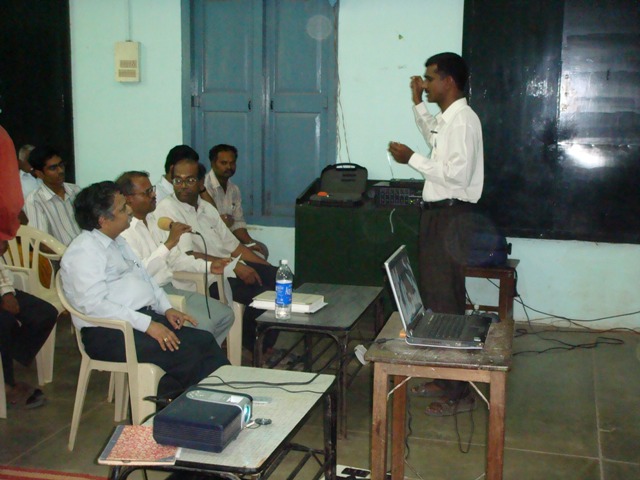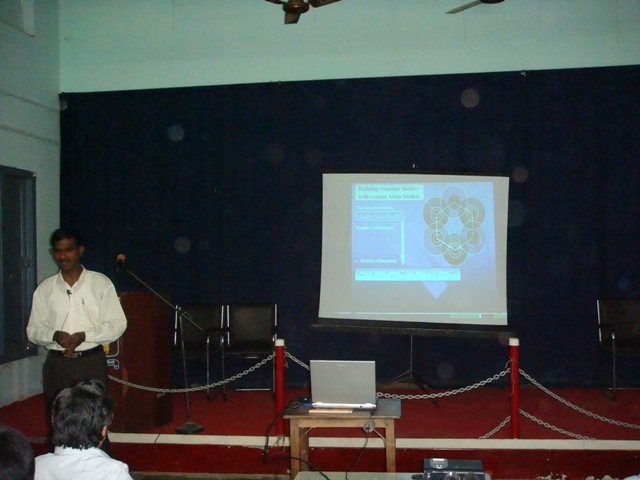
Dr. S. Israel, M.Sc., M.Phil., Ph.D.
Assistant Professor, Department of Physics, The American College, Madurai – 625 002
Mobile: +91-98653 84403,
Email: israel.samuel@gmail.com
Ph.D. Topic:
X-ray studies of the electronic properties of some technologically important semiconductor systems and some ionic solids
Date of Regis: 28.09.2001
Reg. No. 0635
Viva-Voce date: 11.07.2007
Introduction about Ph.D. work:
The research work was based on the understanding on the bonding features of the atoms by investigating the charge density in the unit cell of the chosen material. For my PhD thesis work I had chosen some semiconductor systems and some ionic solids. Si, Ge, GaAs, GaP, InP, ZnSe, ZnTe and CdTe are the semiconductor systems studied extensively using their X-ray diffraction information. Initially the samples were prepared in the form of spheres and single crystal X-ray diffraction data were obtained. The data were corrected for the extinction and absorption effects and were refined for their structure using their atomic positions in the unit cell. The structure factors are carefully refined using various structural and other necessary parameters and are obtained to give low R values. The accurate structure factors are then used for the reconstruction of charge density in the unit cell using Maximum Entropy Method (MEM) technique that is less biased and gives accurate information on the charge density when the available input information is accurate. The charge density in the unit cell is constructed 3-dimensionally and the contour diagrams are drawn in 2-dimensional planes. One dimensional variation along the bonding direction/between the atoms is drawn in order to quantify the results.
The results are amazing and provide intuitive details on how the charges arrange themselves between the atoms and in the unit cell. Elemental semiconductors have different charge arrangement so are the III-V and IV-VI semiconductors. Silicon had its covalent charges gathered in the direction perpendicular to the bonding direction whereas Ge had them exactly in their mid-bond positions. Covalent bonding in Si and Ge are different and their bonding behavior is different and the same are visualized. III-V semiconductors have Non Nuclear Maxima (NNM) perfectly balanced between the atoms involved. Amazingly the radii of the atoms could also be found and they can very well authenticate the type of bonding involved in the system. The IV-VI compound semiconductor systems are partly ionic and partly covalent where the covalent behavior dominates than the other. These systems are also studied upon with the help of Multipole analysis too. The results are interesting.
Presently research work involved in charge density studies on Diluted magnetic semiconductors, materials in nano-form, pharmaceutically important materials and also on important chemicals including minerals. We are presently using both single crystal and powder XRD data and refine them using software like JANA2006. The refined data are further used in the construction of charge density in the unit cell using PRIMA and VESTA softwares.
Materials studied
- LiF
- NaF
- MgO
- CaO
- SrO
- BaO
- CaF2
II-VI SEMICONDUCTORS
- ZnSe - Zinc Selenide
- PbSe - Lead Selenide
- CdTE - Cadmium Telluride
- ZnTe - Zinc Telluride
III-V COMPOUND SEMICONDUCTORS
- InP - Indium Phosphide
- GaP - Gallium Phosphide
ELEMENTAL SEMICONDUCTOR
- Ge - Germanium
List of Publications:
1. Understanding electronic and magnetic transitions in ball milled diluted magnetic semiconductor Si1-xNix through experimental electron density distribution
R.A.J.R. Sheeba, S. Saravanakumar, S. Israel, R. Saravanan,
Journal of Alloys and Compounds 728 (2017) 887-895, (Impact Factor= 3.133).
2. Structural, magnetic and charge-related properties of nano-sized cerium manganese oxide, a dilute magnetic oxide semiconductor
S. Saravanakumar, S. Sasikumar, S. Israel, G.R. Pradhiba, R. Saravanan,
Materials Science in Semiconductor Processing 17 (2014) 186–193,(Impact Factor: 2.359).
3. The analysis on the rearrangement of charge density distribution in response to magnetic behavior in Mn doped SnO2 nanoparticles
S. Saravanakumar, M. Pattammal, S. Israel, R.A.J.R.Sheeba, R. Saravanan,
Physica B: Condensed matter physics, 407 (2012) 302. (Impact Factor: 1.386).
4. Analysis on insulator-metal transition in Yttrium doped LSMO from electron density distribution
S. Israel, S. Saravana Kumar, A. Renuretson, R. A. J. R. Sheeba, R. Saravanan, Bulletin of Material science, Vol.35.No.1 (2012) 111, (Impact Factor: 0.870).
5. Localized ferromagnetic charge ordering through charge density analysis in nano sized diluted magnetic semiconductor Co2+:ZnO
K.S. Syed Ali, R. Saravanan, S. Israel, M. Açikgöz, L. Arda,
Physica B: Condensed matter Physics 405 (2010) 1763–176, (Impact Factor: 1.386).
6. Analysis on experimental valence charge density in Germanium at RT and 200 K
S. Israel, K.S. Syed Ali, R. A. J.R. Sheeba and R. Saravanan,
Journal of Physics and Chemistry of Solids 70 (2009) 1185–1194, (Impact Factor: 2.059).
7. Growth of novel diluted magnetic semiconducting material Ge1-xMnx and X-ray characterization by Maximum Entropy Method (MEM) and Pair Distribution Function(PDF)
R Saravanan, K. S. Syed Ali and S. Israel,
Journal of Crystal Growth 311 (2009) 1110-1116, (Impact Factor: 1.751).
8. X-ray analysis of charge density distribution in GaP at 296 and 200K using Multipole and MEM models
S. Israel, K.S. Syed Ali, R.A.J.R. Sheeba and R. Saravanan, Chinese Journal of Physics 47, 3(2009) 378-400, (Impact Factor: 0.514).
9. Electron density distribution in Si and Ge using multipole, maximum entropy method and pair distribution function
R Saravanan, K. S. Syed Ali and S. Israel,
Pramana – Journal of Physics, 70, 4, (2008) (Impact factor: 1.185)
10. Probabilistic Electron Density Distribution in CdTe at 200 K and 300 K
R. Saravanan, S. Israel, R. K. Rajaram, Y. Ono, M . Isshiki and T. Kajitani., Crystal Research and Technology 3, 41, (2006) (Impact factor: 1.12)
11. Electron density distribution and bonding in ZnSe and PbSe using maximum entropy method (MEM)
K. S. Syed Ali, R. Saravanan, S. Israel, R. K. Rajaram,
Bulletin of Materials Science, 29, No.2, 107-114, Apr.2006, (Impact Factor: 0.870).
12. Bonding in ZnTe at RT, 200 and 100 K Revealed by Entropy Maximized Electron Density Distribution
R. Saravanan, S. Israel and R. K. Rajaram,
Physica B: 363/1-4,166-177, 2005, (Impact Factor: 1.386)
13. Bonding in Fluorite Compound CaF2 Using MEM
R. Saravanan and S. Israel.,
Physica B: 352/1-4, 220-226 (2004) (Impact Factor: 1.386).
14. Electronic Structure of InP at RT, 200K and 100K.
S. Israel, R. Saravanan, and R.K. Rajaram.,
Physica B: 349, 390-400, (2004) (Impact Factor: 1.386).
15. An investigation on the bonding in MgO, CaO, SrO and BaO from the MEM electron density distributions
S. Israel, R. Saravanan, N. Srinivasan and S.K. Mohanlal,
Journal of Physics and Chemistry of Solids, 64, 879-886, (2003) (Impact Factor: 2.059).
16. Electronic Charge Distribution in the Intermetallic Compound MnHg
R. Saravanan, S. Israel, S. Swaminathan, R. Kalidoss and M. Muruganantham,
Crystal Research and Technology, 37, Issue 12, 1310-1317, (2002) (Impact factor: 1.12)
17. High Resolution Electron Density Mapping for LiF and NaF by Maximum Entropy Method (MEM)
S. Israel, R. Saravanan, N.Srinivasan, R. K. Rajaram,
Journal of Physics and Chemistry of Solids, 64/1, 43-49, (2002) (Impact Factor: 2.059).
18. X-ray structure of BaTiO3-Missed Opportunities
K. S. Chandrasekaran, S. K. Mohanlal, R. Saravanan, S.Israel,
Acta Crystallographica, B56, 918-919, (2000). (Impact factor: 2.892)
19. Charge transfer in GaP and InP
R. Saravanan, S.Israel, N. Srinivasan, and S. K. Mohanlal,
Phys. Status Solidi B (Germany), vol.194, no.2, 435-41, 1 APRIL, (1996), Akademie Verlag. (Impact factor: 1.454)
20. Charge transfer in ZnSe
N. Srinivasan, R. Saravanan, S. Israel, and S. K. Mohanlal,
Cryst. Res. Technol. (Germany), vol.31, no.1, K6-8, (1996), Akademie Verlag. (Impact factor: 1.12)
21. Debye-Waller factors in NaxC60
N. Srinivasan, R. Saravanan, S. Israel, and S. K. Mohanlal,
Cryst. Res. Technol. (Germany), vol.30, no.3, K37-9, (1995). (Impact factor: 1.12)
22. f" of silicon from linear absorption measurements
N . Srinivasan, S. Israel, R. Saravanan, and S. K. Mohanlal,
Cryst. Res. Technol. (Germany), vol.30, no.1, K1-3, (1995) (Impact factor: 1.12)

